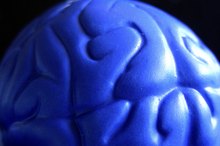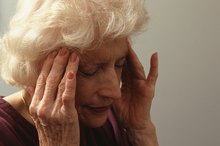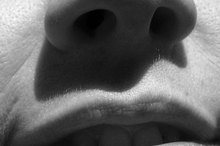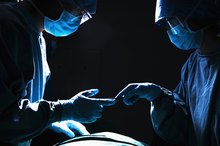What does fact checked mean?
At Healthfully, we strive to deliver objective content that is accurate and up-to-date. Our team periodically reviews articles in order to ensure content quality. The sources cited below consist of evidence from peer-reviewed journals, prominent medical organizations, academic associations, and government data.
The information contained on this site is for informational purposes only, and should not be used as a substitute for the advice of a professional health care provider. Please check with the appropriate physician regarding health questions and concerns. Although we strive to deliver accurate and up-to-date information, no guarantee to that effect is made.
Smell & Signs of a Stroke
When the blood flow to the brain is blocked or decreased, the brain cells in the area of lessened blood flow may die. Fortunately, treatment exists that, when received within 24 hours of the onset of symptoms, can significantly decrease the damage. It’s especially important, then, to know the signs and symptoms of a stroke. Note, however, that not all symptoms must be present to indicate a stroke. If you have any concerns, please contact a medical professional immediately.
If you are experiencing serious medical symptoms, seek emergency treatment immediately.
Smell
There is a fairly common misconception that if you smell something that is not there (such as burnt toast) it is a sign of a stroke. This is not true 1. However, because a stroke can occur in any region of the brain, the sense of smell can be affected. Rather than smelling something that isn’t there, though, it’s more likely that the ability to smell anything will be hindered or that your response to smells is altered.
- There is a fairly common misconception that if you smell something that is not there (such as burnt toast) it is a sign of a stroke.
- Rather than smelling something that isn’t there, though, it’s more likely that the ability to smell anything will be hindered or that your response to smells is altered.
Difficulty Walking
Signs of a Stroke While Sleeping
Learn More
When a stroke occurs it often affects motor control, and one of the most obvious signs of a stroke is the sudden onset of difficulty in walking.
Difficulty Speaking
Motor control in your mouth can be hindered as well and you may experience difficulty speaking. Speaking may also be difficult if the area of your brain responsible for complex thought is affected.
Dizziness
The Medical Conditions That Cause Weakness on the Left Side of the Body
Learn More
The sudden onset of dizziness may also indicate a stroke.
Paralysis
Many stroke victims experience paralysis or numbness on one side of the body. Friends or family may notice a slight drooping and loss of muscle tone on one side.
Vision Problems
If your ability to see is suddenly impaired--in other words, if your vision was fine and then, all of the sudden, it isn't--this may indicate a stroke.
Headache
Although headaches can occur for a number of reasons, a very sudden headache that is accompanied by other symptoms including facial pain or cognitive problems can be a sign of a stroke.
Related Articles
References
- The Mayo Clinic
- The American Heart Association
- Centers for Disease Control and Prevention. Stroke Signs and Symptoms. Updated March 27, 2018.
- Wei CC, Huang SW, Hsu SL, Chen HC, Chen JS, Liang H. Analysis of using the tongue deviation angle as a warning sign of a stroke. Biomed Eng Online. 2012;11:53. doi:10.1186/1475-925X-11-53
- National Institute on Aging. Stroke. Updated May 16, 2017.
- Eissa A, Krass I, Levi C, Sturm J, Ibrahim R, Bajorek B. Understanding the reasons behind the low utilisation of thrombolysis in stroke. Australas Med J. 2013;6(3):152-67. doi:10.4066/AMJ.2013.1607
- Goodwin D. Homonymous hemianopia: challenges and solutions. Clin Ophthalmol. 2014;8:1919-27. doi:10.2147/OPTH.S59452
- National Institute on Deafness and Other Communication Disorders. Aphasia. Updated March 6, 2017.
- National Institute of Neurological Disorders and Stroke. Stroke Information Page. Updated March 27, 2019.
- National Heart, Lung, and Blood Institute. Stroke. Updated August 14, 2018.
- Yanagawa Y, Yoshihara T, Kato H, Iba T, Tanaka H. Significance of urinary incontinence, age, and consciousness level on arrival among patients with stroke. J Emerg Trauma Shock. 2013;6(2):83-6. doi:10.4103/0974-2700.110750
- National Institute of Neurological Disorders and Stroke. Stroke: Hope Through Research. Updated August 13, 2019.
- Rowe FJ. Vision In Stroke cohort: Profile overview of visual impairment. Brain Behav. 2017;7(11):e00771. doi:10.1002/brb3.771
- Genetic and Rare Diseases Information Center. Wallenberg syndrome. 2017.
- Konczak J, Pierscianek D, Hirsiger S, et al. Recovery of upper limb function after cerebellar stroke: lesion symptom mapping and arm kinematics. Stroke. 2010;41(10):2191-200. doi:10.1161/STROKEAHA.110.583641
- Al-Qazzaz NK, Ali SH, Ahmad SA, Islam S, Mohamad K. Cognitive impairment and memory dysfunction after a stroke diagnosis: a post-stroke memory assessment. Neuropsychiatr Dis Treat. 2014;10:1677-91. doi:10.2147/NDT.S67184
- American Stroke Association. About Stroke.
- Kernan WN, Ovbiagele B, Black HR, et al. Guidelines for the prevention of stroke in patients with stroke and transient ischemic attack: a guideline for healthcare professionals from the American Heart Association/American Stroke Association. Stroke. 2014;45(7):2160-236. doi:10.1161/STR.0000000000000024
- National Institutes of Health. NIH Stroke Scale International.








